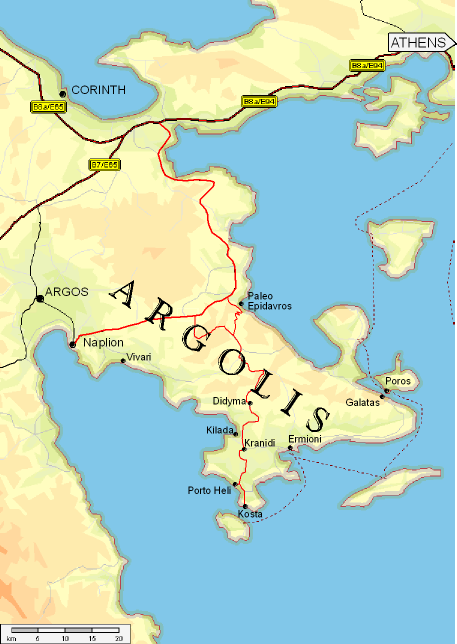
About Argolis |
This section contains some general information about Argolis, the weather conditions and climbing development, first time visitors are well advised to obtain a general tourist guide to the area as well.
|
| General |
The prefecture of Argolis (Argolida) covers most of the eastern finger of the Peloponnese and all but one of the cliffs described lie in this region. The landscape is dry and relatively barren with any forests having long been removed by agriculture and goat herding, though the desertification is nothing like that of the Cycladic islands. The major centres of population are the capital Argos and Naplion, with the coastal strip from Porto Heli to Ermioni along with the area around Tolo being fairly well developed with tourist and holiday accomodation. Apart from in the holiday season the area is quiet with not much to disturb climbers. For some reason Porto Heli is packed full at Easter and accomodation may be harder to find (Note. Orthodox Christian Easter is at different dates to European Easter!) |
| Climate |
Argolis is one of the driest places in Greece and also with the best climate, this is due to the Taygatos and Parnon mountains to the west which remove the bulk of the rain from the approaching frontal systems. From the climbers point of view there are four distinct seasons, just like most places! SPRING. The rainy season is in Febury and predominatly March and these are months to avoid if possible, early April can also have rain and cannot be relied on. Late April, May and June are the ideal time to visit with lush vegetation and spectacular though short-lived flowers. For climbing the temperatures are perfect and the weather generally very stable. The only drawback to visiting at this time of year is the sea temperatures are still fairly low for bathing. SUMMER. Late June,July, August and early September are the classic summer months with temperatures in the 30°c+ region rising to over 40°C in a hot spell. With this in mind we developed a number of cliffs to allow climbing at this time, taking advantage of the strong sea breezes at this time and the higher altitudes available in the mountains. The end result is one of the few areas in Greece where it is possible to climb in near-perfect conditions all the year round. (See the individual cliff descriptions for their suitability). Rain, with the exception of isolated thunderstorms towards the end of the season. is unknown. AUTUMN. The best time to visit with stable, cooler weather in the 20´s and with a warm (25+) sea making bathing a pleasure. After mid September the tourists mostly disappear but most bars and restaurants are still open. WINTER.November and December are still good for climbing but around Christmas and into January there can be a cold northerly wind blowing making climbing uncomfortable, fortunately we have some low level south facing cliffs for this time of year. Snow at the coast is unheard of but the mountains can be covered down to ca. 800m with Didyma being unusable at this time.
|
| Climbing Development |
The only traces of climbing in earlier times are the ascent to the caves in Katafyki Ravine by locals searching for buried treasue in the early seventies, the initials of these pioneers can be seen scratched in the wall of the belay cave of Heroes. An inexplicable line of rusting pitons, very close together and up a crack my dog could climb can be seen by the "Hole In The Wall" as your enter the valley near Candia. Climbing initially started with the ascent of a number of routes at Naplion by Aris Theodoropoulos in the 1980´s but these fell into disuse due partly to a lack of local climbers and also as the mild steel pitons used failed to withstand the ravages of the sea air (the routes are directly above the sea). Modern development started when I moved to the area and started soloing routes and exploring the area for possibilities, bolting was started using a generator and drill but this was a slow and laborious task to say the least, I was fortunate in meeting Inge Zaczek at this time who was keen to learn to climb and together with the purchase of a suitable drill things started to speed up with. A visit to the first Kalymnos climbing festival gave us contact to other climbers, in particular Aris Theodoropoulos who was to give us a great deal of support and help, this spurred us on to greater efforts, the end result after two years work being over 250 routes cleaned and bolted with over 2500 bolts in place. Since moving to Germany and starting a family I have not been able to get much travelling done so things have been quiet on the development front with only Josef Gstoettenmayr and family and Hans Weninger and family steadily putting up new routes apart from the Naplion climbers who appear to have finally got their act together (no doubt with some prodding from Aris) and have finally given this area some worthy routes, I am hoping for great things there in the future! There are still, as far as I know, some free projects awaiting ascents, in particular there are two in Frachti for climbers who like steep 8´s from Karsten Oelze and one at Vivari taking a superb line and probably just in the 9´s. Come on lads! ( and tell me about it!!) |
